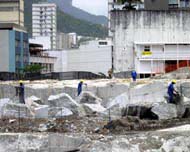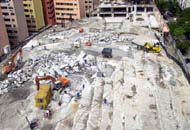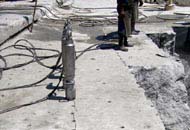Darda ROCK SPLITTERS
Break solid granite like butter



Rio de Janeiro/Blumberg.
The suburb 'Leblon' in Rio de Janeiro is chic and popular - and consequently very built-up. It is here that on the last vacant site - a large granite massif - a large, modern shopping centre with theatre, cine-centre and 240 shops is to be built - 23 000 m² in area. But the whole hard rock massif with a total volume of 30 000 m³ has to be removed first of all in order to allow space for an underground car park. It is here that hydraulic rock and concrete splitting equipment from DARDA is playing a leading role.
Because of the proximity of dwelling houses and businesses, strict rules have to apply during the demolition work: minimum noise and dust, absolutely no vibrations and certainly no shock waves. Work can only be carried out during the day, from nine to five, and no night or weekend shifts. The use of hand-held rock and concrete splitters from DARDA, in combination with diamond wire saws, offered the best solution. Gigantic blocks, 10 metres deep and 15 metres long are cut out and then broken up with splitters.
Success through the alternative offered by the combination approach. The rock is first sawn horizontally in order to produce strata or sections 1.5 to 3.00 metres high. Vertical and lateral incisions are then made to divide the rock into large blocks. These, however, must be further broken up to enable removal off site, a process which is not really commercially feasible using wire saws. This is why DARDA's rock splitters are being used. Several pieces of equipment, consisting in each case of a drive or power source and one or more splitting cylinders, are in operation. First of all holes are drilled at intervals of 30 to 40 cm over the whole length of the block using drilling hammers. The splitting cylinders are then inserted into the boreholes. Using hydraulic pressure, a wedge is pushed forward into the hole and forces the counter wedges surrounding it against the inner walls of the borehole. If several splitting cylinders are used simultaneously then this produces an enormous splitting force. For example, four C12 N cylinders together produce an effective splitting force of 14.028 kN (1.432 tons). In a matter of seconds, a fissure appears in the rock and the direction of this crack can be determined in advance. Thus, the splitting process is absolutely controllable.
The splitting cylinders are moved on and the process is repeated until the block has been cracked along its entire length. With single cylinders the whole block is further reduced into smaller pieces of roughly 30 m3.
But even at this stage the blocks are too big to be transported and so more splitters are used for secondary reduction. The larger blocks are further reduced to a size of about 1 m³ until they can be removed off site with ease. Environmentally friendly and controllable, the advantages offered by this method are clear: it meets the highest demands because the splitting process is quiet and free of dust and vibration. Moreover, there are no pieces of rock flying around in the vicinity. In a few seconds the procedure has been completed.
Furthermore, about 20% of the whole mass of the granite plateau is difficult to access and, therefore, the rock here cannot be broken up using other types of machinery or a wire saw. For the compact tools from DARDA, however, this poses no problems and a substantial part of the rock was removed using DARDA equipment alone.
Other methods of demolition which were considered at the beginning did not meet the challenge. Hydraulic demolition hammers would have caused too much noise, dust and vibration. The use of expanding cement would have meant a long delay between pouring in the cement and the appearance of a crack and progress would have been too slow. The hydraulic splitters from DARDA, in combination with wire saws, won the day because of their 'soft' demolition approach.
